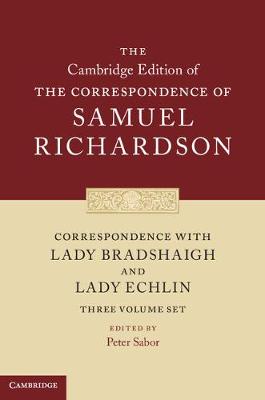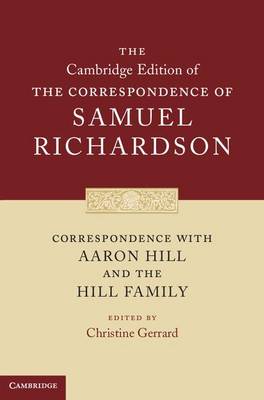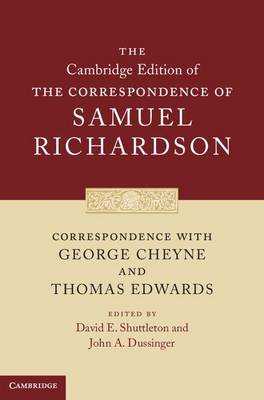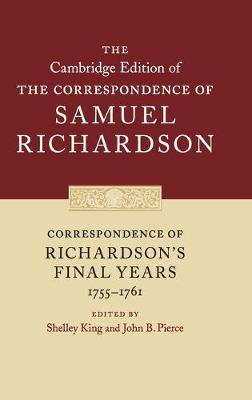The Cambridge Edition of the Correspondence of Samuel Richardson
6 total works
Correspondence with Lady Bradshaigh and Lady Echlin 3 Volume Hardback Set (Series Numbers 5-7)
by Samuel Richardson
Published 17 November 2016
Samuel Richardson (1689-1761), renowned English novelist and master printer, was also a prolific letter writer. The Cambridge Edition of the Correspondence of Samuel Richardson is the first complete edition of his letters. These three volumes contain his correspondence, much of it published for the first time, with two fascinating women: Dorothy, Lady Bradshaigh (1705-85) and her sister Elizabeth, Lady Echlin (1704-82). Lady Bradshaigh was Richardson's most prolific and important correspondent, challenging him about a range of issues, literary and otherwise, including his intentions for Clarissa and Sir Charles Grandison, in an iconoclastic style. Lady Echlin lived in Ireland for much of her life and provided Richardson with information on Irish issues, including the Dublin editions of his novels. The scholarly apparatus in this volume furnishes a wealth of material about these women's lives and their milieu, affording many insights into eighteenth-century English and Irish social and literary history.
Samuel Richardson (1689-1761) was an established master printer when, at the age of 51, he published his first novel, Pamela, and immediately became one of the most influential and admired writers of his time. Not only were all Richardson's novels written in epistolary form: he was also a prolific letter-writer himself. This volume in the first ever full edition of Richardson's correspondence includes his letters to and from Aaron Hill, the poet, dramatist and entrepreneur (1685-1750). Hill was Richardson's earliest literary friend and advisor as he embarked on a new career as a novelist. This correspondence offers fascinating insight into the compositional processes not just of the two Pamela novels, but of Richardson's later novels Clarissa and The History of Sir Charles Grandison. The volume also contains Richardson's correspondence with Hill's three literary daughters, which forms an invaluable chapter in the history of women's writing and literary criticism.
Correspondence with George Cheyne and Thomas Edwards
by Samuel Richardson
Published 19 December 2013
Samuel Richardson (1689-1761), among the most important and influential English novelists, was also a prolific letter writer. Beyond its extraordinary range, his correspondence holds special interest as that of a practising epistolary novelist, who thought long and hard about the letter as a form. The Cambridge Edition of the Correspondence of Samuel Richardson is the first complete edition of his letters. The present volume contains his correspondences with Dr George Cheyne and Thomas Edwards, linked not only by their pronounced medical content but also by their generally unguarded character. An early admirer of Richardson's Pamela (1740-41), Cheyne elicits some of the novelist's most significant statements concerning his own literary practice and tastes. Edwards, an astute literary critic as well as notable sonneteer, draws Richardson into expressing some remarkable insights as a close reader of poetry and prose.
Correspondence with Sarah Wescomb, Frances Grainger and Laetitia Pilkington
by Samuel Richardson
Published 5 November 2014
Samuel Richardson (1689-1761), renowned master printer and celebrated English novelist, wrote hundreds of letters during his lifetime. The Cambridge Edition of the Correspondence of Samuel Richardson is the first complete edition of these letters. This volume contains his correspondences, many published for the first time, with three very different young women, all seeking to find their voice within family and society while corresponding with a celebrated author and moralist. Sarah Wescomb and Frances Grainger, two young, unmarried correspondents, sought paternal advice from the middle-aged author and in the process contested stances taken in his novels. Laetitia Pilkington, an accused adulteress, offers poignant glimpses into an impoverished woman's struggles to survive in Grub Street. The scholarly apparatus in this volume provides ample information about these three women's lives and their milieu, giving fascinating insights into eighteenth-century English social and literary history.
Correspondence Primarily on Sir Charles Grandison(1750–1754)
by Samuel Richardson
Published 26 November 2014
Samuel Richardson (1689–1761) was a highly regarded printer and influential novelist when he produced his final work of fiction, The History of Sir Charles Grandison (1753). Like his other novels, it was written in epistolary form, reflecting his lifelong interest in letter writing and the letter as a genre. Covering the period 1750–1754, many of these fully annotated letters are published from manuscript for the first time, or have been restored to their complete original form. Recording Richardson's relationships with leading cultural figures including Samuel Johnson, Colley Cibber and Elizabeth Carter, the volume reveals his support for other authors while struggling to complete his own 'story of a Good Man'. This publishing saga also incorporates Richardson's responses to the Irish piracy of his novel, and his exchanges with anonymous fans, including those who attacked the novel's tolerance for Catholicism and those who pleaded for a sequel.
Correspondence of Richardson's Final Years (1755–1761)
by Samuel Richardson
Published 5 September 2019
Samuel Richardson (1689–1761) was a prominent eighteenth-century printer and businessman as well as an important and influential English novelist. He was also a prolific letter writer. This volume in the first ever full edition of Richardson's correspondence offers a fascinating glimpse of the writer in his final years - at the height of his professional powers but facing the challenging circumstances of physical decline and commercial conflict. The collection of miscellaneous letters addresses a variety of issues ranging from details of Richardson's printing operation to his mentorship of women writers including Sarah Fielding, Anna Meades and Frances Sheridan. Other correspondents of note include Samuel Johnson, Meta Klopstock, Thomas Sheridan and Tobias Smollett. Taken together this series of letters draws an intimate picture of Richardson's professional and personal circles as they exchange family gossip, business advice, literary anecdotes and news of the day.





